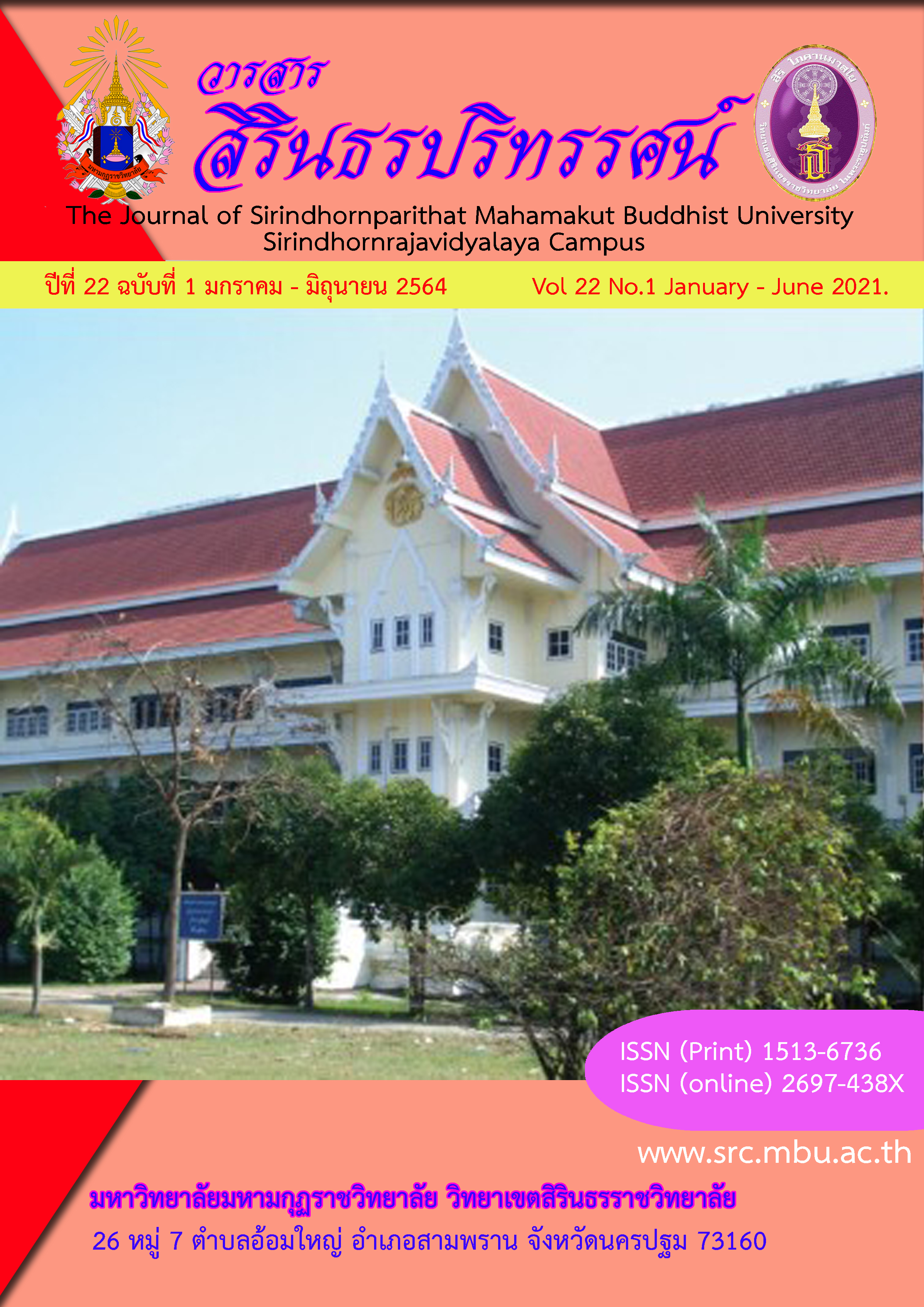การประเมินหลักสูตรครุศาสตรมหาบัณฑิต สาขาวิชาการบริหารการศึกษา (หลักสูตรปรับปรุง พ.ศ. 2560) มหาวิทยาลัยราชภัฏหมู่บ้านจอมบึง
บทคัดย่อ
การวิจัยครั้งนี้มีวัตถุประสงค์เพื่อประเมินหลักสูตรครุศาสตรมหาบัณฑิต สาขาวิชาการบริหารการศึกษา (หลักสูตรปรับปรุง พ.ศ. 2560) มหาวิทยาลัยราชภัฏหมู่บ้านจอมบึง โดยใช้รูปแบบการประเมิน CIPPiest Model ตามแนวคิดของสตัฟเฟิลบีมและชอง กลุ่มตัวอย่างที่ใช้ในการวิจัยครั้งนี้ ได้แก่ คณะกรรมการบริหารหลักสูตร อาจารย์ผู้สอน ศิษย์เก่า นักศึกษาปัจจุบัน และผู้ใช้บัณฑิต จำนวน 76 คน โดยใช้วิธีสุ่มกลุ่มตัวอย่างแบบแบ่งชั้นตามสัดส่วน เครื่องมือที่ใช้ในการเก็บรวบรวมข้อมูล คือ แบบสอบถามแบบมาตรประมาณค่า 5 ระดับ มีค่าความเชื่อมั่นเท่ากับ 0.93 สถิติที่ใช้ในการวิเคราะห์ข้อมูล ได้แก่ การแจกแจงความถี่ ค่าร้อยละ ค่าเฉลี่ย และส่วนเบี่ยงเบนมาตรฐาน
ผลการวิจัย พบว่า
1) ด้านบริบทของหลักสูตร ในภาพรวมมีค่าเฉลี่ยอยู่ในระดับมาก เมื่อพิจารณาเป็นรายได้พบว่า วัตถุประสงค์ของหลักสูตรมีค่าเฉลี่ยอยู่ในระดับมากที่สุด ส่วนด้านอื่นมีค่าเฉลี่ยอยู่ในระดับมากโดยเรียงลำดับค่าเฉลี่ยจากมากไปหาน้อยดังนี้ โครงสร้างของหลักสูตร และเนื้อหาสาระรายวิชา
2) ด้านปัจจัยนำเข้า ในภาพรวมและรายด้านมีค่าเฉลี่ยอยู่ในระดับมากทุกด้าน โดยเรียงลำดับค่าเฉลี่ยจากมากไปหาน้อยดังนี้ ด้านความพร้อมและความเหมาะสมของนักศึกษา ด้านปัจจัยที่เอื้อต่อการจัดการเรียนการสอน และด้านความพร้อมและความเหมาะสมของอาจารย์ผู้สอน
3) ด้านกระบวนการ ในภาพรวมและรายด้านมีค่าเฉลี่ยอยู่ในระดับมากทุกด้าน โดยเรียงลำดับค่าเฉลี่ยจากมากไปหาน้อยดังนี้ ด้านการบริหารหลักสูตร และด้านการจัดการเรียนการสอน
4) ด้านผลผลิต ในภาพรวมและรายด้านมีค่าเฉลี่ยอยู่ในระดับมาก โดยเรียงดับค่าเฉลี่ยจากมาไปหาน้อยดังนี้ ด้านความรู้ ด้านทักษะทางปัญญาด้านทักษะในการวิเคราะห์เชิงตัวเลขการสื่อสารและการใช้เทคโนโลยีสารสนเทศ ด้านทักษะความสัมพันธ์ระหว่างบุคคลและความรับผิดชอบ ด้านคุณธรรม จริยธรรม
5) ด้านผลกระทบ ในภาพรวมและรายข้อมีค่าเฉลี่ยอยู่ในระดับมาก
6) ด้านประสิทธิผล ในภาพรวมและรายข้อมีค่าเฉลี่ยอยู่ในระดับมากที่สุด
7) ด้านความยั่งยืน ในภาพรวมและรายข้อมีค่าเฉลี่ยอยู่ในระดับมาก
8) ด้านการถ่ายโยงความรู้ ในภาพรวมและรายข้อมีค่าเฉลี่ยอยู่ในระดับมาก
เอกสารอ้างอิง
ธัชชัย จิตรนันท์, จิราพร วิชระโภชน์. (2015) การประเมินหลักสูตรการศึกษามหาบัณฑิต สาขาวิชาการบริหาร การศึกษา(หลักสูตรปรับปรุง 2554) คณะศึกษาศาสตร์ มหาวิทยาลัยมหาสารคามโดยใช้รูปแบบการประเมิน CIPP Model. วารสารการบริหารและพัฒนา มหาวิทยาลัยมหาสารคาม ปีที่ 7 ฉบับที่ 1 มกราคม-เมษายน 2558
ปิยฉัตร กลิ่นสุวรรณ (2563) การวิจัยประเมินหลักสูตรปรัชญาดุษฎีบัณฑิต สาขาวิชาการบริหารสวัสดิการสังคม (หลักสูตรใหม่ พ.ศ. 2557). วารสารสังคมภิวัฒน์ ปีที่ 11ฉบับที่. 1 มกราคม- เมษายน 2563
ปยะธิดา ปญญา (2562) การประเมินหลักสูตรปรัชญาดุษฎีบัณฑิตสาขาวิจัยและประเมินผลการศึกษามหาวิทยาลัยราชภัฏมหาสารคาม. วารสารมหาวิทยาลัยราชภัฏมหาสารคาม. ปที่ 13 ฉบับที่ 2 : พฤษภาคม - สิงหาคม 2562
ภารดี อนันต์นาวี; เจริญวิชญ์ สมพงษ์ธรรม (2558) การประเมินหลักสูตรการศึกษามหาบัณฑิต สาขาวิชาการบริหารการศึกษา ฉบับปรับปรุง พ.ศ. 2554 มหาวิทยาลัยบูรพา. ค้นเมื่อ กุมภาพันธ์ 12, 2563 จาก http://dspace.lib.buu.ac.th/xmlui/handle/1234567890/1751
มัทนา วังถนอมศักดิ์ (2554) การประเมินหลักสูตรปรัชญาดุษฎีบัณฑิต สาขาวิชาการบริหารการศึกษา วารสาร ศิลปากรศึกษาศาสตร์วิจัยปีที่ 3 ฉบับที่ 1, 2 (กรกฎาคม - ธันวาคม 2554)
สมชัย พุทธา (2556) การประเมินผลหลักสูตรศึกษาศาสตรมหาบัณฑิต สาขาวิชาการบริหารการศึกษา คณะศึกษาศาสตรมหาวิทยาลัยกรุงเทพธนบุรี วารสารวิชาการ มหาวิทยาลัยราชภัฏพระนคร. ปีที่ 4 ฉบับที่ 2: พฤษภาคม-ตุลาคม 2556
สมปอง ชาสิงห์แก้ว, พระครูสโมธานเขตคณารักษ์, พระอธิการบุญช่วย โชติวํโส และสุนทร สายคำ.(2561) การประเมินหลักสูตรพุทธศาสตรมหาบัณฑิต สาขาวิชาการบริหารการศึกษา ฉบับปรับปรุง พ.ศ. 2555.มหาวิทยาลัยมหาจุฬาลงกรณราชวิทยาลัย วิทยาเขตขอนแก่นวารสารวิชาการธรรมทรรศน์ปีที่ 18 ฉบับที่ 1 (มกราคม - เมษายน 2561)
สมศักดิ์ บุญปู่ และพีรวัฒน์ ชัยสุข. (2558) การประเมินหลักสูตรพุทธศาสตรดุษฎีบัณฑิต สาขาวิชาพุทธบริหารการศึกษาภาควิชาบริหารการศึกษา คณะครุศาสตร์ มหาวิทยาลัยมหาจุฬาลงกรณราชวิทยาลัย. วารสารครุศาสตร์ปริทรรศน์ฯ ปีที่ 2 ฉบับที่ 3 กันยายน-ธันวาคม 2558
สุกัญญา แช่มช้อย และพฤทธิ์ ศิริบรรณพิทักษ์. (2563). การประเมินการพัฒนาคุณภาพโรงเรียนขยายโอกาสทางการศึกษาและมัธยมศึกษาในสังกัดองค์การบริหารส่วนจังหวัดนนทบุรี ปีการศึกษา 2557-2559 วารสารศึกษาศาสตร์ มหาวิทยาลัยนเรศวรปีที่ 22ฉบับที่ 1มกราคม -มีนาคม2563
สำนักงานเลขาธิการสภาการศึกษา 2563, ข้อเสนอเชิงนโยบาย เกี่ยวกับการพัฒนาคุณภาพการศึกษาเชิงระบบ ค้นเมื่อ กุมภาพันธ์ 12, 2563 จาก http://www.onec.go.th/th.php/book/BookView/1817
Krejcie, R. V. & D. W. Morgan, (1970). Determining Sample Size for Research Activities. Educational and Psychological Measurement, 30(3), pp. 607-610.
Stufflebeam. Daniel L., Guili Zhang (2017). The CIPP Evaluation Model: How to Evaluate for Improvement and Accountability. New York: Guilford Press.
The Economist Intelligent Unit (2020). THAILAND 2035: HORIZON SCANNING OVERVIEW. An assessment of critical factors impacting Thailand’s development prospects to 2035 Retrieved January 10, 2021, from: https://www.ippd.or.th/wp-content/uploads/2020/04/ Thailand-2035-Horizon-Scanning-Overview-3.pdf
ดาวน์โหลด
เผยแพร่แล้ว
ฉบับ
ประเภทบทความ
สัญญาอนุญาต
บทความที่ได้รับการตีพิมพ์เป็นลิขสิทธิ์ของ มหาวิทยาลัยมหามกุฏราชวิทยาลัย วิทยาเขตสิรินธรราชวิทยาลัย
ข้อความที่ปรากฏในบทความแต่ละเรื่องในวารสารวิชาการเล่มนี้เป็นความคิดเห็นส่วนตัวของผู้เขียนแต่ละท่านไม่เกี่ยวข้องกับหาวิทยาลัยมหามกุฏราชวิทยาลัย วิทยาเขตสิรินธรราชวิทยาลัย และคณาจารย์ท่านอื่นๆในมหาวิทยาลัยฯ แต่อย่างใด ความรับผิดชอบองค์ประกอบทั้งหมดของบทความแต่ละเรื่องเป็นของผู้เขียนแต่ละท่าน หากมีความผิดพลาดใดๆ ผู้เขียนแต่ละท่านจะรับผิดชอบบทความของตนเองแต่ผู้เดียว




